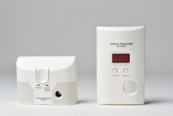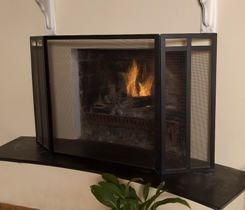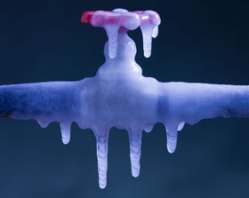
Home fires occur more in winter than in any other season. As you stay cozy and warm this winter season, be fire smart! Here are some helpful safety tips:
Carbon Monoxide Safety

Carbon monoxide, also known as CO, is called the "invisible killer" because it's a colorless, odorless, poisonous gas. More than 150 people in the United States die every year from accidental non-fire related CO poisoning associated with consumer products.
See more Carbon Monoxide Tips here: Carbon Monoxide Safety Page
General Safety

- Keep an emergency supply kit in your home that includes a battery-powered radio with extra batteries, canned food and a manual can opener, flashlights and battery-powered lamps for power failures, wood for fireplaces, and rock salt to melt ice and sand to improve traction.
- Make sure your car is in proper working condition and includes blankets, warm clothing, booster cables and tools, bottled water, dried fruits and nuts, a first aid kid, a fire extinguisher, flashlights and batteries, a shovel and ice scraper
- Wear layers to protect yourself from the cold. A hat, scarf and mittens are also essential protection against winter weather.
- Always use a flashlight – not a candle – for emergency lighting.
- Some smoke alarms may be dependent on your home's electrical service and could be inoperative during a power outage. Check to see if your smoke alarm uses a back-up battery and install a new battery at least once a year.
- If the there is a fire hydrant near your home, keep it clear of snow, ice and debris for easy fire department access.
For more information, click on these links:
- Get ahead of the Winter Freeze. (PDF) – National Fire Protection Agency
- Stay Safe in Cold Weather (PDF) – National Institute on Aging
- Winter Fire Safety Tips for the Home (PDF) – FEMA
Generator Safety
- Follow the manufacturer's instructions and guidelines when using generators.
- Use a generator or other fuel-powered machines outside the home. CO fumes are odorless and can quickly overwhelm you indoors.
- Use the appropriate sized and type power cords to carry the electrical load. Overloaded cords can overheat and cause fires
- Never connect generators to another power source such as power lines. The reverse flow of electricity or "backfeed" can electrocute an unsuspecting utility worker.
Heating Safety

Heating equipment is a leading cause of home fire deaths. Almost half of home heating equipment fires are reported during the months of December, January, and February. Some simple steps can prevent most heating-related fires from happening.
- Install and maintain carbon monoxide (CO) alarms to avoid the risk of CO poisoning.
- If you smell gas in your gas heater, do not attempt to light the appliance. Turn off all the controls and open doors and windows. Call a gas service person.
- Test smoke alarms at least monthly
- Fireplace and Wood Stove Safety
- Heating your Home Safely

Preventing Frozen Pipes
Frozen pipes are not just an inconvenience. An average of a quarter-million homes are damaged and lives disrupted each winter, all because of frozen water pipes. An eighth-inch crack in a pip can spew up to 250 gallons of water a day, destroying floors, furniture, and personal property. Both plastic (PVC) and cooper pipes can burst.
Before the cold hits:
- Insulate pipes in crawl spaces and attics, the ones most susceptible to freezing. Remember: the more insulation, the better protected your pipes will be.
- Heat tape or thermostatically-controlled heat cables can be used to wrap pipes. Use only products approved by an independent testing organization, such as Underwriters Laboratories, and only for the use intended (exterior or interior).
- Seal leaks that allow cold air inside, especially near the location of pipes. Look for air leaks around electrical wiring, dryer vents, and pipes. use caulk or insulation to keep cold air out and the heat in. With severe wind chill, a tiny opening can let enough cold air inside to cause a pipe to freeze.
- Disconnect garden hoses and, if practical, use an indoor valve to shut off and drain water from pipes leading to outside faucets. This reduces the chance of freezing in the short span of the pope just inside the house.
When the mercury drops:
- A trickle of water might be all it takes to keep your pipes from freezing. Let warm water drip overnight, preferably from a faucet on an outside wall.
- Open cabinet doors to allow heat to get to uninsulated pipes under sinks and appliances near exterior walls.
If you are away:
- Set the thermostat no lower than 55 degrees F.
- Ask a friend or neighbor to check our house daily to make sure it's warm enough to prevent freezing, or…
- Shut of and drain the water system. Be aware that if you have a fire protection sprinkler system in your house, it will be deactivated when you shut off the water.
If your pipes freeze:

- Don't take chances. If you turn on your faucets and nothing comes out, leave the faucets turned on and call a plumber. If you detect your water pipes have frozen, turn off the water at the main shut-off valve in the house; leave the water faucets turned on.
- Never try to thaw a pipe with a torch or other open flame. Water damage is preferable to fire damage. You may be able to thaw a frozen pipe with the warm air from a hair dryer. Start by warming the pipe close to the faucet as possible, working toward the coldest section of pipe.
- Do Not use electrical appliances in areas of standing water because electrocution is possible.
Make sure everyone in your family is aware of where the water shut-off valve is and how to open and close it.
*Sources: United States Fire Administration and the National Fire Protection Association.*
